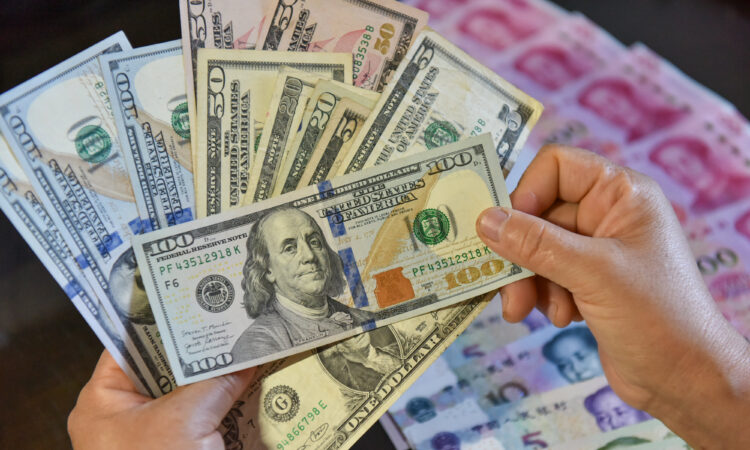
In this photo illustration, the man is holding several U.S. dollar bills with some Chinese yuan in the background.
Sopa Images | Lightrocket | Getty Images
The euro dropped to $1.064 and was last down 0.8%. The common European currency was on track to have fallen 1.5% this week, its biggest weekly decline since September 2022.
A hot U.S. inflation report on Wednesday caused investors to rein in their bets on Fed rate cuts this year, moving the estimated start date to September and pulling back on how many there will be.
But on Thursday the ECB signaled it was still likely to start cutting rates this summer, given that inflation has fallen more sharply in the single-currency bloc.
“The comments that we’ve had from ECB officials are that June is still on the cards and maybe more moves after that,” said Jane Foley, head of FX strategy at the Dutch bank Rabobank.
“They seem to be acknowledging that there will be a divergence from the Fed and I think that was reassurance for speculators this morning … hence the move in the euro,” Foley added.
A weaker euro isn’t necessarily a concern for European policymakers, potentially helping exporters in Germany, where growth has been weak, the strategist noted.
The dollar index, which tracks the currency against six leading currencies, including the euro and yen, was last up 0.7% at 106.0, also a five-month high. It has jumped 1.5% this week, the biggest weekly gain since February.
The difference in interest rate expectations has pushed the gap between U.S. bond yields and German benchmark yields to the highest since 2019, making U.S. bonds more attractive and boosting the dollar.
Britain’s pound was trading at its lowest since mid-November, another victim of dollar strength, down 0.8% at $1.2446.
The strong dollar kept the Japanese yen under pressure. The U.S. currency rose to its highest since mid-1990 on Friday at 153.39 yen. It was last trading nearly unchanged at 153.19 yen.
The threat of currency intervention by Japanese authorities appeared to keep the yen steadier than other currencies on Friday after Finance Minister Shunichi Suzuki said: “If there are excessive moves, we will respond appropriately without ruling out any options.”
The Japanese currency was set for a weekly decline of more than 1% and has slumped some 8% since the start of the year as Japanese interest rates stay far below those in the U.S.
“They have to support the yen, it’s in freefall,” said Tony Sycamore, a market analyst at IG. “So there has to be some measures soon. The question is at what level and at what time do they decide to put some money down.”
China’s yuan was little changed after data that showed March exports contracted sharply, while imports also unexpectedly shrank, both missing market forecasts by big margins.
The yuan has fallen to its lowest since November at around 7.238 to the dollar as China has struggled to regain momentum and U.S. growth has remained strong.
Elsewhere, the dollar also gained sharply against Sweden’s crown after data showed Swedish inflation slowed more than expected in March, bolstering hopes that the central bank in Stockholm will be cutting interest rates soon.
The dollar was last up 1.04% at 10.83 crowns, a five-month high.


